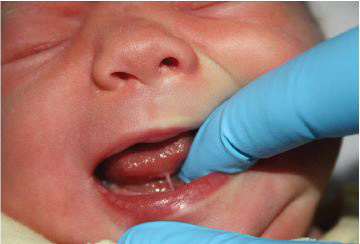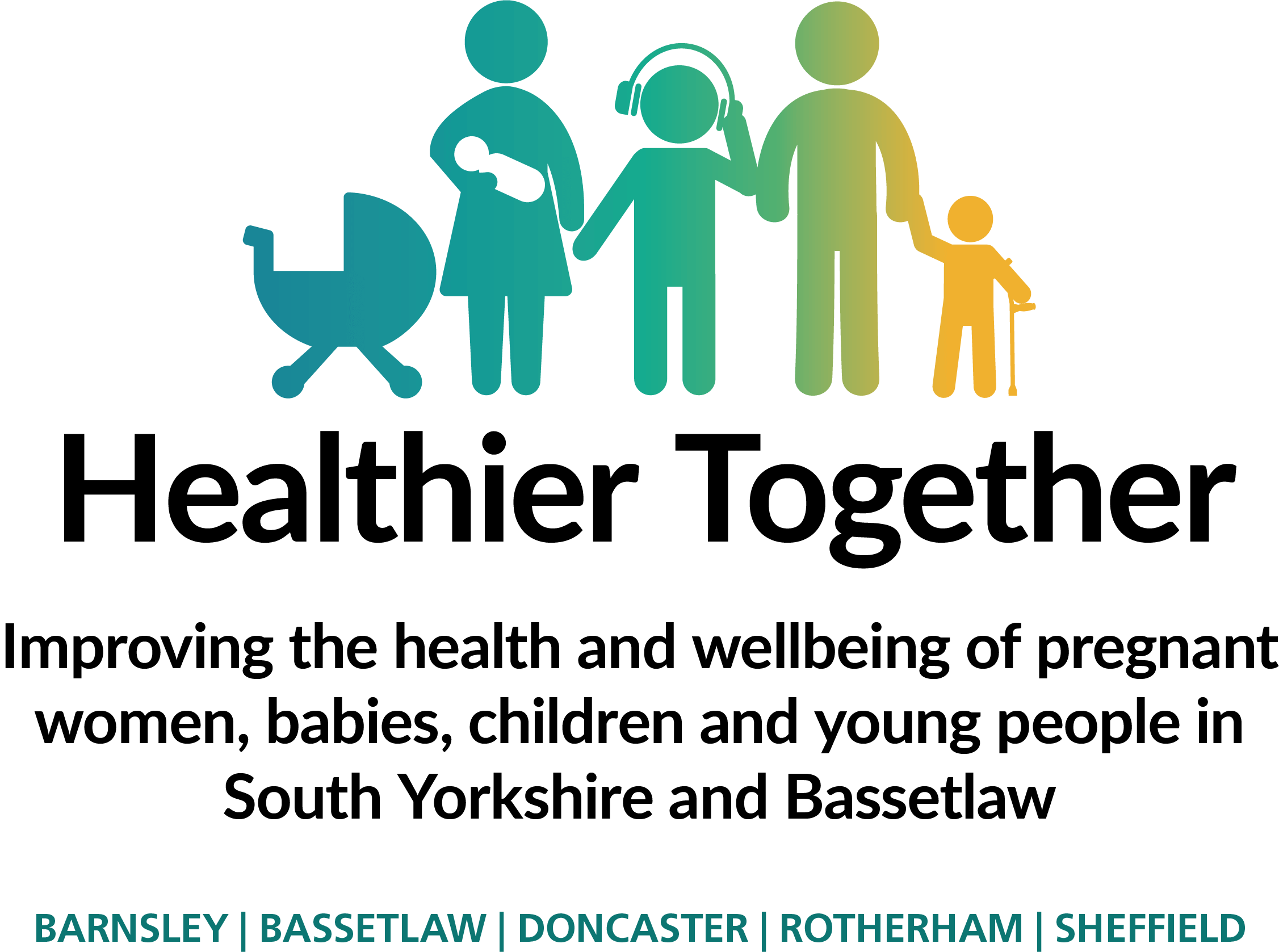Tongue-tie
 This page explains what a tongue-tie is, what the implications of a tongue-tie are for both you and your baby, and what treatment options are available. We hope it will help to answer some of the questions you may have. If you have any further questions or concerns, please speak to a member of your healthcare team.
This page explains what a tongue-tie is, what the implications of a tongue-tie are for both you and your baby, and what treatment options are available. We hope it will help to answer some of the questions you may have. If you have any further questions or concerns, please speak to a member of your healthcare team.
What is a tongue-tie?
Tongue-tie (ankyloglossia) is a condition present at birth that restricts the movement of a baby’s tongue.
The underside of the tongue is connected to the floor of the mouth by a piece of tissue known as the lingual frenulum. In babies with tongue-tie, the frenulum is thicker and/or tighter (shorter) than usual. This restricts the movement of their tongue and can cause problems with feeding. A tongue-tie can involve the entire underside of the tongue or just part of it.
Tongue-tie is thought to affect approximately one in ten (10%) babies and is more common in boys than girls. About half of babies with a tongue-tie have someone else in the family who also has one.
Signs and symptoms of a tongue tie
Tongue-tie is sometimes identified during a baby’s newborn physical examination, but it’s not always easy to spot. It may not become obvious until your baby has problems feeding (breastfeeding and bottle feeding). For some babies, the effects of tongue-tie will be quite mild. For others, tongue-tie can make feeding extremely difficult. We have listed some of the common signs of tongue-tie to look out for in the table on the next page:
| Method of feeding | Baby’s symptoms | Mother’s symptoms |
|---|---|---|
| Breastfeeding |
Your baby may:
|
You may:
|
| Bottle feeding |
Your baby may:
|
You may:
|
You and your baby may experience some or all of these symptoms, so it may not be obvious that they have a tongue-tie
Understanding why your baby experiencing difficulties with feeding
Breastfeeding
Your baby may find it difficult to latch on to your breast if:
- they are not able to open their mouth wide enough
- their tongue is unable to cover their lower gum
- the movement of their tongue during suckling differs from their usual rhythmical pattern
If your baby is unable to latch on successfully, they may begin to nipple feed rather than breastfeed. This prevents them from taking the milk from your breast efficiently and it also causes damage to your nipples.
Bottle feeding
Your baby may find it difficult to create a seal around the teat. This may cause their suck to be inefficient and the feed to take longer. Your baby may also dribble a lot of milk out of the sides of their mouth.
If you are concerned about your baby’s feeding and think they may have a tongue-tie, please speak to your midwife or health visitor. They will do a feeding assessment. If a tongue-tie is suspected of causing the feeding problem, you will be asked if you would like an appointment with a tongue-tie specialist midwife. If your baby is too old to be seen in a midwifery led clinic you will be referred to a clinic specifically for older babies.
Assessing the severity of your baby's tongue-tie
If you or your baby is experiencing a feeding problem, please ask for help. You will receive feeding support and, if a tongue-tie is suspected, a feeding assessment will take place. With your permission a referral will be made to a tongue-tie specialist. A referral does not mean your baby will definitely be offered a division. The specialist will be looking at many different factors and will talk you through the findings and options.
Tongue-tie release (frenulotomy)
Tongue-tie release is a very simple procedure, particularly in babies under six months of age. The procedure only takes a few seconds and does not require an anaesthetic (medicines used to numb sensation in certain areas of the body or induce sleep). Babies are likely to cry immediately after the procedure, although the majority of babies cry for less than a minute.
The use of tongue-tie release to improve feeding is supported by the National Institute of Clinical Excellence (NICE). It is considered a safe and simple procedure which demonstrates significant improvements in feeding, particularly breastfeeding, where a reduction in nipple pain and an improved ability to latch on to the breast has been consistently identified.
Before the procedure
If we recommend that your baby has the procedure, we will discuss it with you in more detail and ask for your consent.
Your baby must have had either the Vitamin K injection or the second dose of oral drops (if they are having oral Vitamin K) more than 24 hours before the procedure.
You will also need to confirm that your baby is fit and well with no known medical conditions at the time of their feeding assessment. If you or your baby’s father has a blood clotting disorder, or there is a family history of blood clotting disorders, please discuss this with us during your baby’s feeding assessment.
During the procedure
- We will wrap your baby securely in a blanket and hold them gently to keep their head still. Some babies may not like this.
- We will then release the tongue-tie using sterile, round-ended scissors. We will then apply some pressure under your baby’s tongue to stop any bleeding using a piece of sterile gauze. There will usually only be a few drops of blood.
- Once we have released the tongue-tie, we will unwrap your baby and encourage them to feed straight away. This will help your baby’s tongue to move and may prevent the tongue-tie from re-fusing.
You may remain with your baby for the duration of the procedure or, if you prefer, your midwife can take your baby to a separate room.
We will support you to feed your baby after the procedure. We will also discuss a management plan with you to help you with your ongoing feeding experience.
The decision to have your baby’s tongue-tie released is a personal one. If you choose not to have the procedure, we will continue to give you feeding support. If at a later date you are concerned about your baby’s feeding, please contact your health visitor or GP. They can refer you for another tongue-tie assessment.
After the procedure
A small white blister may develop under your baby’s tongue in the first couple of days after the procedure. As far as we can tell, this is painless and does not interfere with feeding.
Your baby may be fussy and unsettled for a few days after the procedure. It may also take a few weeks before your baby is fully comfortable when feeding. Occasionally, the procedure may not improve a baby’s ability to feed.
Possible risks
As with any surgical procedure, there are some possible risks, but these are rare. Risks include:
- excessive bleeding
- infection
- ulcers
- pain
- damage to the tongue and surrounding tissues
Very occasionally, a tongue-tie may reoccur if the frenulum re-fuses. This may be due to residual frenulum or the development of scar tissue. If this happens, a further procedure may be necessary.
We will explain these risks to you in more detail before you agree to the procedure.
The future
Occasionally, tongue-ties can persist and while the majority of children have no difficulties with their speech, the presence of a tongue-tie has been shown to influence the ability to pronounce certain sounds in some children. However, it is impossible to predict which children will be affected, or to determine whether treatment as a baby will prevent this.
Speech difficulties are usually noticeable by the time a child reaches three years of age. If you think your child’s speech is affected or they are having problems caused by tongue-tie, contact your GP or health visitor and they will be able to refer your child to a speech and language therapist for an assessment.
Further information
NHS choice website: www.nhs.uk/conditions/tongue-tie
Association of Tongue-tie Practitioners
Website: www.tongue-tie.org.uk/help-and-information-for-parents



